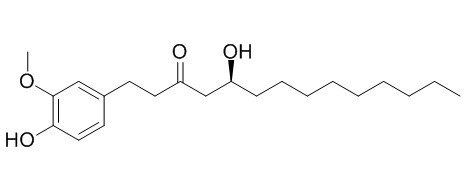10-Gingerol
10-Gingerol has anti-cancer, anti-neuroinflammatory, and anti-bacterial effects, it effectively inhibits the growth of the oral pathogens, and inhibits exogenous ghrelin deacylation.10-Gingerol induces [Ca2+]i rise by causing Ca2+ release from the endoplasmic reticulum and Ca2+ influx from non-L-type Ca2+ channels in SW480 cancer cells.10-Gingerol-induced apoptosis was accompanied by phosphorylation of the mitogen-activated protein kinase (MAPKs) family, c-Jun N-terminal kinase (JNK), p38 MAPK (p38), and extracellular signal-regulated kinase (ERK).
Inquire / Order:
manager@chemfaces.com
Technical Inquiries:
service@chemfaces.com
Tel:
+86-27-84237783
Fax:
+86-27-84254680
Address:
1 Building, No. 83, CheCheng Rd., Wuhan Economic and Technological Development Zone, Wuhan, Hubei 430056, PRC
Providing storage is as stated on the product vial and the vial is kept tightly sealed, the product can be stored for up to
24 months(2-8C).
Wherever possible, you should prepare and use solutions on the same day. However, if you need to make up stock solutions in advance, we recommend that you store the solution as aliquots in tightly sealed vials at -20C. Generally, these will be useable for up to two weeks. Before use, and prior to opening the vial we recommend that you allow your product to equilibrate to room temperature for at least 1 hour.
Need more advice on solubility, usage and handling? Please email to: service@chemfaces.com
The packaging of the product may have turned upside down during transportation, resulting in the natural compounds adhering to the neck or cap of the vial. take the vial out of its packaging and gently shake to let the compounds fall to the bottom of the vial. for liquid products, centrifuge at 200-500 RPM to gather the liquid at the bottom of the vial. try to avoid loss or contamination during handling.
Asian J of Pharmaceutical&Clinical 2018, 11(2)
Am J Chin Med.2023, 51(4):1019-1039.
J Food Biochem.2019, 43(9):e12970
Korean. J. Pestic. Sci.2024, 28(3):241-248.
Cell Mol Biol(Noisy-le-grand)2019, 65(7):77-83
OENO One2023, 57:3.
J Ethnopharmacol.2024, 320:117426.
J Biol Chem.2021, 297(6):101362.
Cancer Sci.2022, 113(4):1406-1416.
BioResources J.2020, 15(3).
Related and Featured Products
Food Chem. 2013 Dec 1;141(3):3183-91.
Anti-neuroinflammatory capacity of fresh ginger is attributed mainly to 10-gingerol.[Pubmed:
23871076]
Despite the anti-neuroinflammatory capacity of ginger, the corresponding active constituents are unclear.
METHODS AND RESULTS:
This study analyzed the composition of fresh ginger ethanolic extract by using LC-MS. Inhibitory activities of fresh ginger extract and seven gingerol-related compounds on the neuro-inflammation were also evaluated by using a lipopolysaccharide (LPS)-activated BV2 microglia culture model. Except for zingerone and 6-gingerol, other gingerols and shogaols at a concentration of 20 μM inhibited the production of nitric oxide, IL-1β, IL-6 and TNF-α as well as their mRNA levels in LPS-activated BV2 microglia. Blocking NF-κB activation was the underlying mechanism responsible for inhibiting the proinflammatory gene expression. Increasing the alkyl chain length enhanced the anti-neuroinflammatory capacity of gingerols yet, conversely, attenuated those of shogaols. 6-Gingerol was the most abundant compound in the fresh ginger extract, followed by 10-Gingerol. Furthermore, fresh ginger extract exhibited a significant anti-neuroinflammatory capacity, which was largely owing to 10-Gingerol, but not 6-gingerol.
Biochem Biophys Res Commun. 2011 Sep 2;412(3):506-11.
10-Gingerol, a component of rikkunshito, improves cisplatin-induced anorexia by inhibiting acylated ghrelin degradation.[Pubmed:
21846463]
Rikkunshito (RKT), a Japanese traditional medicine, has been shown to stimulate food intake in rats with cisplatin-induced anorexia; however, the underlying mechanisms remain unknown.
METHODS AND RESULTS:
In this study, we investigated whether RKT is involved in the degradation of peripheral ghrelin. RKT inhibited decreases in plasma ghrelin level and enhanced acyl- to desacyl-ghrelin (A/D) ratio in cisplatin-treated rats. Several components of RKT demonstrated inhibitory activity against ghrelin deacylating enzymes. In addition, 10-Gingerol, a component of RKT, inhibited exogenous ghrelin deacylation.
CONCLUSIONS:
Therefore, RKT may enhance plasma acyl-ghrelin level, at least in part, by inhibiting the circulating ghrelin degrading enzyme.
In Vitro Cell Dev Biol Anim. 2015 Jan;51(1):92-101.
10-Gingerol induces mitochondrial apoptosis through activation of MAPK pathway in HCT116 human colon cancer cells.[Pubmed:
25148824]
The present study was designed to investigate the molecular mechanisms of 10-Gingerol activity against HCT116 human colon cancer cells.
METHODS AND RESULTS:
10-Gingerol inhibited the proliferation of HCT116 cells by 50% at a concentration of 30 μM, and this inhibition was dose-dependent accompanied by the morphological changes indicative of apoptosis. Furthermore, flow cytometric analysis showed that 10-Gingerol increased DNA in the sub-G1 phase of the cell cycle, and the extent of apoptosis was confirmed by Annexin V and PI double staining.
CONCLUSIONS:
Analysis of the mechanism of these events indicated that 10-Gingerol -treated cells exhibited an increased ratio of Bax/Bcl-2, resulting in the activation of caspase-9, caspase-3, and poly-ADP-ribose polymerase in a dose-dependent manner, which are hallmarks of apoptosis. Moreover, 10-Gingerol-induced apoptosis was accompanied by phosphorylation of the mitogen-activated protein kinase (MAPKs) family, c-Jun N-terminal kinase (JNK), p38 MAPK (p38), and extracellular signal-regulated kinase (ERK).
Oncol Rep. 2016 Feb;35(2):779-84.
10-Gingerol inhibits proliferation and invasion of MDA-MB-231 breast cancer cells through suppression of Akt and p38MAPK activity.[Pubmed:
26554741 ]
METHODS AND RESULTS:
In the present study, we investigated the roles and molecular mechanism of 10-Gingerol, a phenolic compound isolated from Zingiber officinale, in regulating cell proliferation and invasion of MDA‑MB‑231 breast cancer cells. 10-Gingerol treatment inhibited cell proliferation through downregulation of cell cycle regulatory proteins such as cyclin-dependent kinases and cyclins, and subsequent induction of G1 phase arrest. In addition, 10‑gingerol treatment blocked cell invasion in response to mitogenic stimulation. These antitumor activities of 10‑gingerol were mediated through inactivation of Akt and p38MAPK activity, and suppression of epidermal growth factor receptor expression.
CONCLUSIONS:
Collectively, these findings demonstrate the pharmacological roles of 10-Gingerol in regulating breast cancer cell growth and progression, and suggest further evaluation and development as a potential therapeutic agent for the prevention and treatment of breast cancer.



